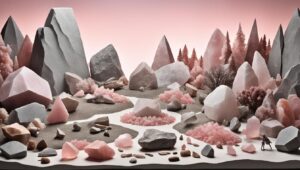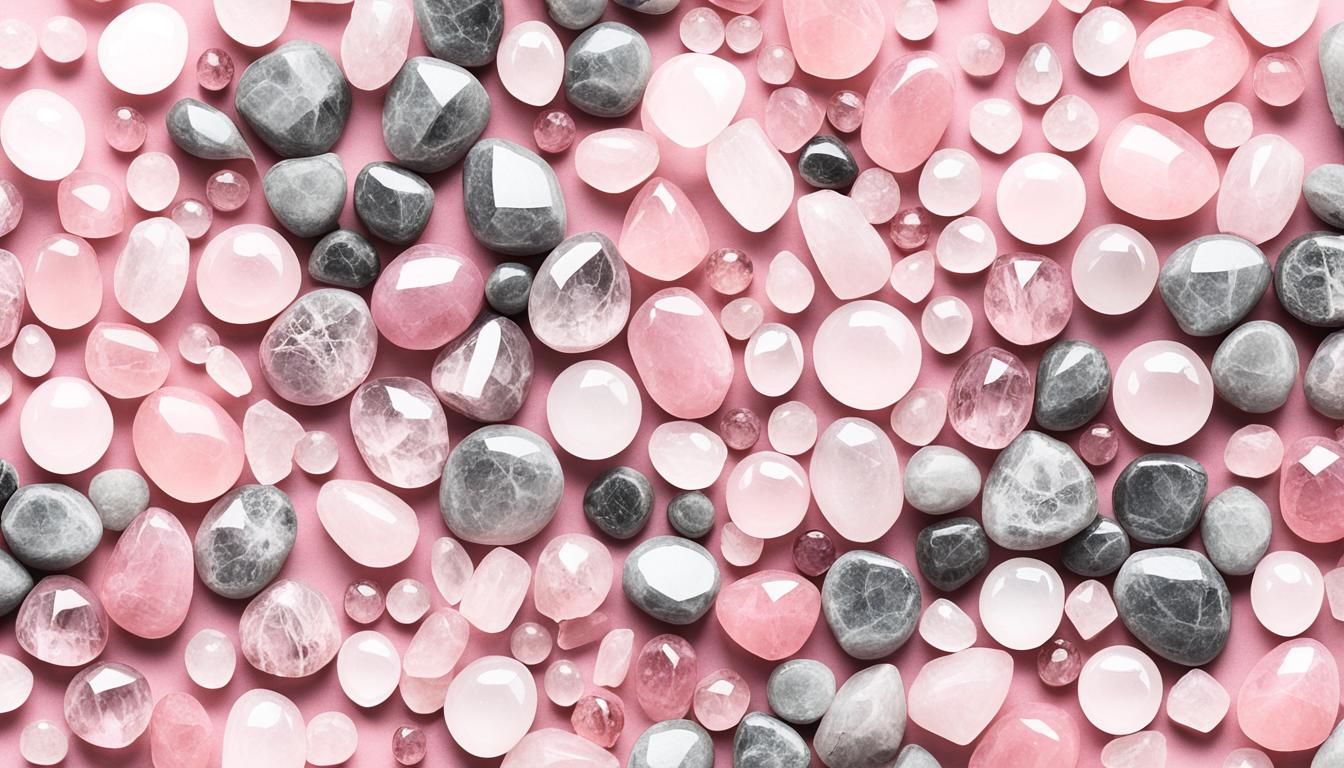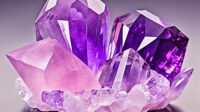Rose quartz is pink, and smoky quartz is gray. These distinct colors are what sets them apart. But what is the true statement here? It’s that color is the best way to identify a mineral. When it comes to rose quartz and smoky quartz, their colors are the key distinguishing factor.
Rose quartz, with its delicate pink hue, is often associated with love, compassion, and emotional healing. It is believed to attract positive energy and promote self-love. On the other hand, smoky quartz, with its smoky gray color, is known for its grounding and protective properties. It is believed to absorb negative energy and provide a sense of stability.
So, if you stumble upon a pink crystal, you can be sure it’s rose quartz. And if you come across a crystal with a gray color, it’s most likely smoky quartz. Understanding the colors of these minerals can help you appreciate their unique meanings and properties.
- Rose quartz is pink and smoky quartz is gray.
- Color is the best way to identify a mineral.
- Rose quartz is associated with love and emotional healing.
- Smoky quartz is known for its grounding and protective properties.
- The colors of these minerals are due to minor impurities.
The Geological Importance of Quartz
Quartz, with its unique properties, plays a vital role in the Earth’s geology. It is a common component of silica-rich igneous rocks and can account for up to 25% of the volume of granites. This abundance emphasizes the significant presence of quartz in the Earth’s crust.
Quartz also occurs in hydrothermal veins, forming when mineral-rich water circulates through fractures in rocks. These veins often contain quartz along with other minerals, creating visually striking formations.
Furthermore, quartz is prevalent in sedimentary rocks, which are formed through the accumulation of sediment over time. The stable nature of quartz at surface temperatures and pressures makes it a significant component of sandstones and siltstones, adding strength and durability to these formations.
Quartzite, the metamorphosed equivalent of quartz-rich sandstone, is another important geological formation where quartz is found. It exhibits extreme hardness and is often used as a building material and decorative stone.
Quartz, with its abundance in various geological settings, showcases its geological importance and impact on different rock formations.
Quartz Properties in Geological Settings
| Property | Description |
|---|---|
| Silica-Rich Igneous Rocks | Quartz is a common component of silica-rich igneous rocks, such as granites. |
| Hydrothermal Veins | Quartz forms in hydrothermal veins, along with other minerals, resulting in visually stunning formations. |
| Sedimentary Rocks | Quartz is abundant in sedimentary rocks like sandstones and siltstones, providing strength and durability. |
| Quartzite | Quartz-rich sandstone metamorphoses into quartzite, a durable and popular building material. |
Through its presence in various geological formations, quartz demonstrates its significance and influence on the Earth’s crust. Its unique properties and abundance contribute to the diverse and captivating landscapes we observe today.
The Economic Importance of Quartz
Quartz plays a crucial role in various industries, making it economically significant. Its unique properties and versatility make it a sought-after material in multiple applications.
Glass Production
One of the primary uses of quartz is in glass production. In fact, most glass is predominantly made from quartz. The high silica content in quartz enables it to undergo the necessary chemical reactions during the glass-making process, resulting in transparent and durable glass products.
Construction Industry
The construction industry heavily relies on quartz due to its abundance and desirable properties. Quartz is commonly used as an aggregate in concrete, providing strength and stability to structures. It is also used as a key component in mortar and cement, contributing to their adhesive and binding properties.
Quartz Sand
Quartz sand, also known as silica sand, is extensively used in various construction activities. Its finely grained texture makes it an ideal material for mortar and concrete production. Quartz sand is also widely employed in landscaping, as it enhances drainage and soil structure.
Piezoelectric Properties
Quartz exhibits piezoelectric properties, which means it can generate an electric charge when subjected to mechanical stress. This unique characteristic makes quartz invaluable in various technological applications, such as measuring pressures and controlling electric impulses in devices like radio systems and timepieces.
To summarize, quartz is economically important due to its use in glass production, the construction industry, and its piezoelectric properties. Its versatility and abundance make it a highly sought-after material in multiple sectors.
The Physical Characteristics of Quartz
Quartz is a fascinating mineral with unique physical characteristics. Let’s explore some of its defining features.
Quartz Hardness
One of the remarkable properties of quartz is its hardness. It ranks 7 on the Mohs scale, indicating its high level of resistance to scratching and abrasion. This makes quartz a very durable mineral, suitable for various applications.
Color Variations
Quartz exhibits a range of colors due to minor impurities present during its formation. The most well-known color variations include pink crystals, known as rose quartz, and gray or cloudy white crystals, known as smoky quartz. These color variations add to the visual appeal and versatility of quartz.
Conchoidal Fracture
When quartz fractures, it does so in a unique manner called conchoidal fracture. This means that it breaks with smooth, curved surfaces, resembling the shape of a seashell. The conchoidal fracture of quartz adds to its aesthetic charm and makes it suitable for crafting into various ornamental pieces.
Quartzite and Chert
Quartz can occur in different forms, such as quartzite and chert. Quartzite is a metamorphic rock formed from the recrystallization of quartz-rich sandstone under high heat and pressure. Chert, on the other hand, refers to microcrystalline quartz that occurs in chalk or limestone. These variations in quartz’s composition and structure contribute to its wide distribution and diverse range of uses.
| Characteristics | Description |
|---|---|
| Hardness | 7 on the Mohs scale |
| Color Variations | Pink (rose quartz) and gray/cloudy white (smoky quartz) |
| Fracture | Conchoidal (smooth, curved surfaces) |
| Forms | Quartzite (metamorphic rock) and Chert (microcrystalline quartz) |
Quartz is a versatile mineral that offers both stunning aesthetics and remarkable physical properties. Its hardness, color variations, conchoidal fracture, and occurrence in different forms like quartzite and chert make it a captivating and valuable mineral in various industries and applications.
The Historical and Cultural Significance of Quartz
Quartz has a rich history and holds significant cultural importance. From ancient civilizations to modern times, this versatile mineral has served various purposes and played a role in shaping human development.
In the Stone Ages: Quartz Tools as Indispensable Assets
During the Stone Ages, when technology was at its early stages, quartz emerged as a game-changer. With its exceptional hardness and ability to break with sharp edges, quartz became a crucial material for crafting tools. It surpassed the limitations of wood and bone, allowing our ancestors to create more durable and efficient implements quartz tools in Stone Ages. These tools revolutionized hunting, gathering, and overall survival strategies, enabling communities to thrive in challenging environments.
Versatility in Glass Production
Glass production has long relied on quartz as its backbone because of the mineral’s abundance and desirable properties. Quartz serves as the primary component in various glass products, providing transparency, durability, and thermal stability. Whether it’s the window panes of architectural marvels or the intricate designs of stained glass artworks, quartz’s vital role in glassmaking cannot be overstated glass production.
Survival Tool: Quartz’s Ability to Spark Flames
Quartz has also proven to be an invaluable asset for survival. When struck against iron-containing rocks like chert, quartz produces a long-lasting spark, making it a reliable ignition source for starting fires. This knowledge has been passed down through generations, providing a means to kindle warmth, cook food, and ward off potential dangers. The durability and availability of quartz make it a crucial tool for survival in challenging environments survival tool.
Formation of Diatomaceous Earth: Nature’s Powerful Resource
Quartz plays a crucial role in the natural formation of diatomaceous earth, a remarkable substance with diverse applications. Diatomaceous earth is created from the remains of tiny aquatic organisms called diatoms, which have a silica-based cell wall enriched with quartz. This mineral-loaded substance finds its way into various industries, such as water filtration, agricultural pest control, and as an abrasive in toothpaste. Its unique properties make it a sought-after resource in multiple fields diatomaceous earth.
Throughout history, quartz has left an indelible mark on human culture, from ancient societies relying on quartz tools to modern industries harnessing its potential. With its multifaceted contributions to our world, quartz continues to captivate and inspire. Its historical and cultural significance is a testament to the enduring role this remarkable mineral plays in our lives.
| Quartz Significance | Historical and Cultural Context |
|---|---|
| Quartz Tools in Stone Ages | Stone Age civilizations utilized quartz for its hardness and ability to create sharp tools, revolutionizing hunting and survival techniques. |
| Glass Production | Quartz serves as the main component in glassmaking, providing transparency, durability, and thermal stability. |
| Survival Tool | Quartz generates sparks when struck against iron, enabling the creation of long-lasting flames for essential survival needs. |
| Diatomaceous Earth | Quartz’s presence in the formation of diatomaceous earth gives rise to a powerful resource used in water filtration, agriculture, and manufacturing. |

Conclusion
In conclusion, rose quartz is a beautiful pink crystal that is associated with love and emotional healing. Its vibrant color and soothing energy make it a popular choice in jewellery and crystal healing practices. On the other hand, smoky quartz is characterized by its gray color and is known for its grounding and protective properties. It is believed to absorb negative energy and promote a sense of calm and stability.
When it comes to identifying minerals, color is often the best indicator. The distinct pink hue of rose quartz and the gray shade of smoky quartz make them easily recognizable. However, it is important to note that color variations can occur due to minor impurities, adding to the uniqueness and allure of these crystals.
Quartz, in its various forms, is a versatile and captivating mineral. Its diverse range of colors, economic uses, and significant geological and historical importance make it a fascinating subject of study and a cherished gemstone loved by many.






